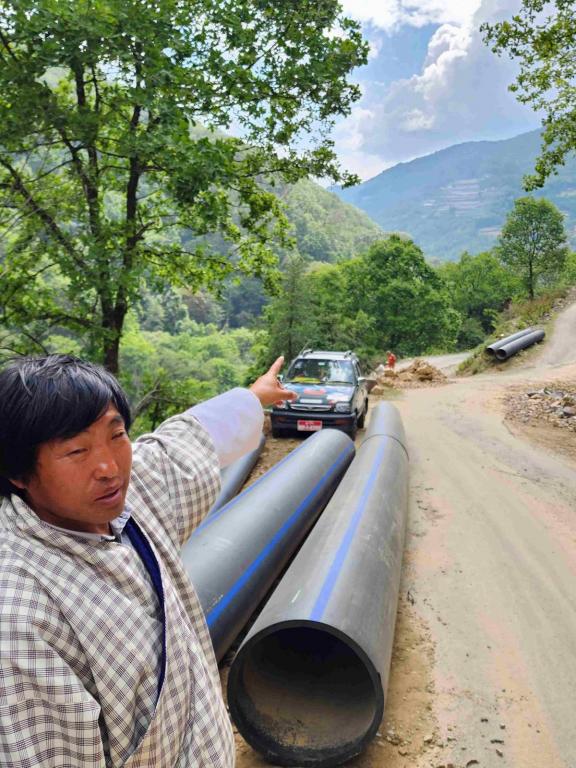Of prayer flags and readiness: Notes from an evaluation mission in Bhutan
It is easy to romanticize Bhutan. In sharp contrast to the location of our GCF office, the air feels clean; there is such little traffic that the country doesn’t even have a traffic light, the flight takes you over some really dense conifers, you can communicate with everyone in English, and things seem… easy. When you walk through the village trails, there is the sense of unhurried breeze blowing through the leaves. The landscape is dramatic – now deep gorges, and now rolling hills – all lush green and rich with life. Historic monasteries are perched on the steepest cliffs. Prayer flags are in every corner and the symbols of a traditional society are visible in everything, from the way men and women dress to architecture. “We wouldn’t even think about it", says a travel companion when I ask if they would visit a temple if they happened to be wearing western clothes. His Majesty’s picture is visible in every office too, conveying a sense of dignified authority, stability, and statesmanship.
That is my long-winded way of saying that there is a palpable sense of national and cultural pride in Bhutan. This is a country where the government workforce is highly educated (and typically in top western universities). There is a strong sense of organization. Even our mission meetings are all lined up punctually, and everything is in perfect order.
Yet there is a sense of foreboding. Climate change is very real here. The country is figuratively and literally quite locked. This is an agrarian, land-locked, seismically active, nature dependent society with a small population and the strategic location that is the darling of all the larger powers that surround it. Bhutan has chosen not to pursue a western market-based model of development and has instead chosen to develop slowly. At one point during the week, there is a moment of confusion among the interviewees and interviewers on ‘private sector’. For us, ‘private sector’ carries notions of large corporate entities. GCF projects in Bhutan have instead envisaged local communities to supply labour, and this is the private sector. Such is the relationship with agriculture that paddy cultivation makes for a cover page story in the national daily, including the challenges of human wildlife conflict, urbanization, and labour shortages. Water is a major issue facing the country that already has tough terrain for agriculture. Why then hasn’t it used more GCF readiness support and resources? Do they even distinguish between readiness and Funding Proposals (FPs)?
Of Projects and Readiness
The enthusiasm of Sherub Gyeltshen (pictured above) is infectious. He is the project manager for GCF project FP107, Supporting Climate Resilience and Transformational Change in the Agriculture Sector in Bhutan. We are walking along some of the irrigation infrastructure in various stages of operation and construction, as part of the project. Sherub points excitedly in all directions, he wants us to see it all, he has ready responses for questions of all manner, and his energy does not sap. Clearly, this is a man who loves his job. He was trained in development economics, but his current jobs needs him to be an engineer, a manager, community mobilizer, all rolled into one.
After our formal interview is over, we start talking about general mechanics of the project. During the formal and informal discussions, several implementation challenges come up. The project is delayed, partly because of Covid-19 and partly because of vagaries of implementation. In the several years that lapse between design and implementation, realities of the world have changed. The prices of commodities and personnel have changed, as have the demands of farming communities. This creates an awkward situation for the project: whether to implement activities as promised to the GCF originally, or adjust to the realities and needs of the community?
Can readiness cover implementation? Can this support make communities ready to access finance? Can the GCF use its readiness support to provide for the flexibility that is otherwise necessary? Can readiness be used to add that extra bit, make the projects go the ‘last mile’, which becomes evident only during implementation?
Of Transformations Big and Small
During one of the site visits, we are faced with a humbling situation. The beneficiaries of the project want to offer us a token. They have a gift from their first harvest – vegetables, fruits, and rice – and they want to send it to the GCF as a token of appreciation. Of course, the IEU is not the intended recipient of the gifts, and we are passing it to the GCF Secretariat and the Board (see here). During the discussions, the beneficiaries tell us about how their lives have been transformed because of assured access to quality and quantity of water. But this transformation is not the only one we come across.
The other transformation is far less pleasant. There is an ‘exodus’ of trained workers from the civil services. Bhutan has been losing a large part of its trained and educated workforce to the west. ‘A move to Australia’ is a jab they take at each other, partly in joke, but partly in anticipation of departments left with minimal workforce.
Of Consultants and Pending Questions
There are other transformations on the horizon. We have arrived at the cusp when the next five-year plan of the country is about to be finalized. Everyone looks to the plan for outlining the priorities. Bhutan is also graduating from its LDC status in late 2023, and there is a sense of anticipation about what this may mean for development assistance. Taking these factors into account, all agencies will set about doing their work. The questions I am left asking:
-
There is an overwhelming cluster of development partners in Bhutan. And there is fatigue, or rather a frustration, as to why each one is different and demanding in its own way. “Can they not coordinate together instead of asking us to coordinate them”?
- The GCF is a source of large finance for climate. But it remains a somewhat distant and passive partner. Does it want to be a closer partner? Does it want to actively build capacities and help with the national planning?
- There is an onus on the country to plan for the planning. A country like Bhutan is excellent at planning. There is a culture and tradition of national planning, with strong alignment among line departments. But would this work in another context with weaknesses in national planning?
- The use of international consultants. The issue comes up often in the development and climate context. Covid-19 further exposed the dependence of the development assistance on international consultants. At some point, someone called it the consultant industry or consultant machinery. Is there a way to address this in a direct or even indirect way?
It is hard for me to not feel uneasy, as we head back. Yet, our interviewees are not as agitated as I feel. There is a sense of urgency, but it isn’t accompanied by my sense of anxiety. Perhaps in a deeply spiritual society, things have a sense of calm instead of calamity. The omnipresent prayer flags and forbidding nature do fill you with a sense of peace rather than disquiet. It feels as though we will figure it out… eventually.
The mission was undertaken as part of the IEU evaluation of the GCF readiness program. The report of the readiness evaluation by the IEU will be available here later in the year.
Disclaimer: The views expressed in blogs are the author's own and do not necessarily reflect the views of the Independent Evaluation Unit of the Green Climate Fund.

